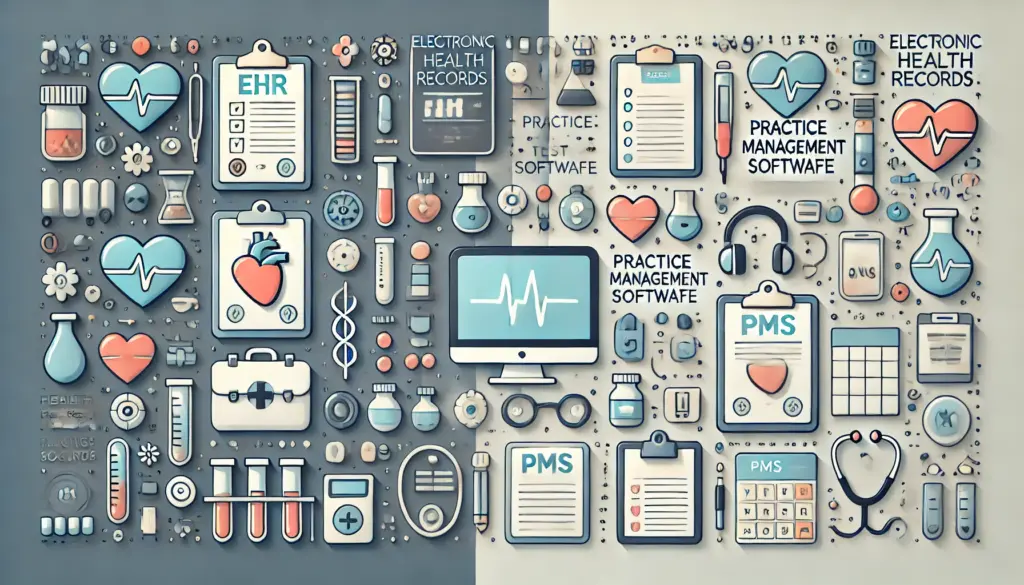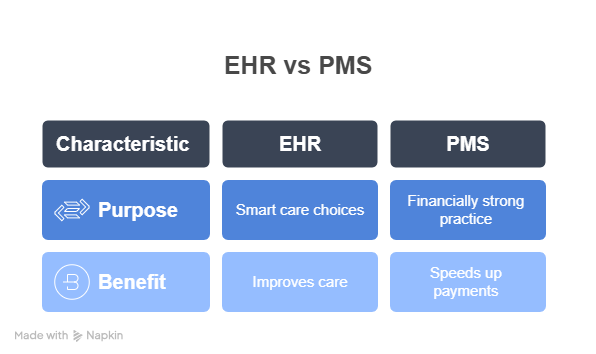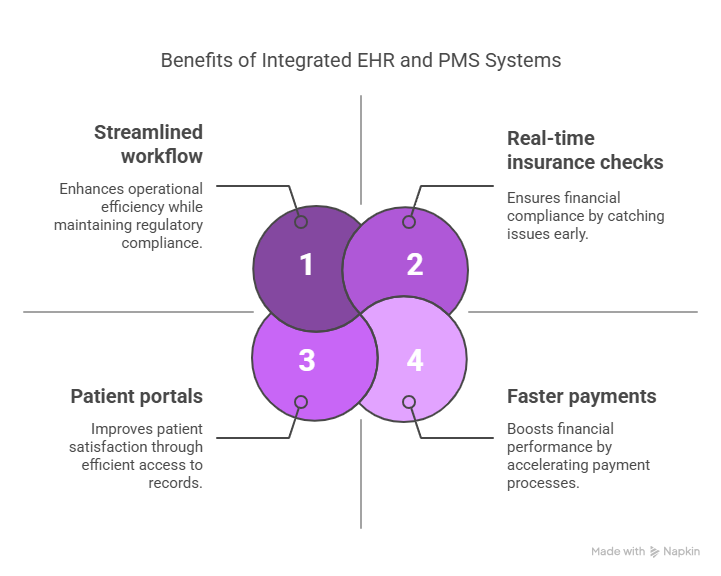EHR vs. Practice Management System: A Complete Guide
23 Apr 2025 By: Mary Dellosa
Updated

Healthcare providers now rely on tech like EHR and Practice Management System. Though often confused, each plays a key but different role in running a medical practice.
If you manage a practice or advise on healthcare tech, knowing how EHR and PMS differ is key. This guide shows their features, pros, cons, and real uses to help you determine the difference between EHR vs. Practice Management System.
What is Electronic Health Records (EHR)?
An Electronic Health Record, or EHR, is a digital version of your medical chart. Instead of keeping everything on paper, your health information is safely stored on a computer—so doctors and nurses can easily access and update it.
An EHR keeps track of things like:
- Your past and current diagnoses
- Medications you’re taking
- Treatment plans
- Vaccinations (shots)
- Allergies
- X-rays and imaging
- Lab results
- Notes from your doctors
- Ongoing care for chronic conditions
The goal of EHRs is to make healthcare smoother, safer, and more connected. They help your care team work together by letting them securely share your information—whether you’re visiting your family doctor, going to a specialist, or showing up at the ER.
EHRs also help doctors follow important health rules, like protecting your privacy (HIPAA) and improving care quality (MACRA).
In short, EHRs help your healthcare providers see the big picture—so you get better care with fewer delays and less paperwork.
What is Practice Management System?
What is a Practice Management System?
A Practice Management System (PMS) helps run the business side of a doctor’s office or clinic. While doctors focus on treating patients, the PMS makes sure everything behind the scenes is organized.
It helps with things like:
- Booking and managing appointments
- Sending reminders so patients don’t forget their visits
- Handling insurance claims
- Sending bills and tracking payments
- Keeping an eye on how much money is coming in
- Creating reports to see how the practice is doing
- Helping staff stay on top of their daily tasks
Think of it as the office manager in digital form, it keeps things running smoothly so everyone can focus more on patient care and less on paperwork.
While the EHR takes care of your health info, the PMS handles the day-to-day tasks and finances. When both work together, the whole practice runs better for patients, staff, and providers.
Core Differences Between EHR vs. Practice Management System
| Feature | EHR | Practice Management System |
|---|---|---|
| Purpose | Manages patient clinical data | Manages administrative & financial tasks |
| User | Doctors, nurses, clinical staff | Office managers, receptionists, billing team |
| Data Managed | Health history, lab results, prescriptions | Appointments, insurance, billing |
| Compliance | Strong focus on medical compliance (HIPAA, MU) | Financial compliance and auditing |
| Communication | Interoperability with other EHR systems | Insurance providers and clearinghouses |
| Documentation | Clinical notes, progress reports | Claims submissions, invoice tracking |
Why You Usually Need Both EHR and PMS
Most practices use both to give great care and run well. Here’s why:
- EHR helps doctors make smart care choices
- PMS keeps the practice financially strong
- Using both improves care and speeds up payments
Still, some cases may call for using one more than the other.

When EHR Alone Might Be Enough
EHR can work solo in small clinics or where admin work is outsourced. It fits best for:
- Telehealth-only setups
- Clinics in Health Info Exchanges (HIEs)
- Research-focused groups
Here, the main goal is to store and share patient data, not handle billing and share patient data securely.
When PMS Alone Might Be Enough
Some groups may use PMS without EHR, such as:
- Therapists or chiropractors using simple records
- Billing firms handling many providers
- Consultants focused on scheduling and payments
Still, skipping EHR can cause issues in audits or care coordination.
Benefits of Using Both: The Integrated Advantage
Using both EHR and PMS brings major perks. It creates a smoother, smarter practice.

1. Streamlined Workflow
- Sync clinical data to billing without extra work
- Cut down on repeated data entry
- Speed up check-ins and check-outs
2. Improved Revenue Cycle Management
- Catch insurance issues early with real-time checks
- Get paid faster
- Fix claim issues more easily
3. Better Patient Engagement
- Patients book visits and see records in portals
- Auto reminders reduce no-shows and boost satisfaction
4. Compliance and Reporting
- Use one view for MU, MIPS, and MACRA
- Keep clean audit logs and records
Choosing the Right System: Key Questions
Ask these before you choose:
- Do I need EHR, PMS, or both?
- What’s my team size and workflow?
- Do I need links to labs, imaging, or clearinghouses?
- Do I want cloud or on-site systems?
- What’s the total cost—license, training, upkeep?
- Is vendor support solid and up-to-date?
Trending Now
The rollout of electronic health records (EHR) in NHS hospitals poses major patient safety risks, with under-reported incidents linked to software issues and user errors. A charity, Patient Safety Learning, urged better monitoring after one trust reported over 900 incidents. Though EHR systems aim to improve care by replacing paper notes, implementation has caused direct harm in some cases. Government reviews and new clinical risk standards are planned. Despite most issues causing low harm, concerns remain over system integration and staff training. Trusts stress transparency and ongoing improvements to ensure patient safety.
Top Vendors Offering EHR and PMS Solutions
Here are trusted names in the market:
- Epic Systems
- Great for big hospitals
- Customizable but pricey
- Epic Systems
- Athenahealth
- Cloud-based
- Includes EHR, PMS, and telehealth
- Athenahealth
- Kareo
- Built for small practices
- Simple, with billing built in
- Kareo
- AdvancedMD
- Modular design
- Offers EHR, PMS, and HR tools
- AdvancedMD
- DrChrono
- iPad-friendly
- Ideal for small or mobile practices
- DrChrono
Cost Considerations
Prices depend on:
- Number of users or providers
- Cloud vs. on-site setup
- Extra tools like telehealth or mobile apps
- Training and setup support
As a ballpark estimate:
| System Type | Monthly Cost (per provider) |
|---|---|
| EHR only | $200 – $700 |
| PMS only | $100 – $400 |
| Integrated EHR + PMS | $300 – $1000+ |
Revenue Models and Cost Flexibility
Some vendors offer flexible pricing. Instead of flat fees, they may charge based on claim volume or revenue share. This suits smaller or growing practices.
Challenges with EHR and PMS Implementation
Even the best tools can fail without the right setup. Common issues include:
- Poor training: Staff can’t use the system well
- Data migration: Trouble moving old records
- Hidden costs: Fees for upgrades or add-ons
- Downtime: Bugs or outages slow work
Solution: Choose vendors with solid onboarding and live help.
Future Trends: What’s Next in EHR and PMS
Healthcare technology is changing fast. Watch for:
- AI and predictive tools: Spot illness early, auto-schedule
- Voice-to-text: Faster charting
- Blockchain: Safer, sharable records
- Remote monitoring: Better care from home
- Custom mobile apps: More ways to connect with patients
Smart clinics will pick systems that grow with them.
Frequently Asked Questions
Conclusion: EHR vs PMS – Work Together, Not Against
It’s not about choosing one. The best move is to use both. EHR and PMS together help your clinic run better, improve patient care, and earn faster.
Pick a system that offers both. You’ll save time, avoid mistakes, and treat patients better.
FAQ’s
An Electronic Health Record (EHR) is a digital version of a patient’s chart that stores medical history, diagnoses, medications, allergies, lab results, imaging, and clinical notes in one secure system. It’s mainly used by doctors, nurses, and other clinical staff to see the “big picture” of a patient’s health and support safer, more coordinated care. HelpSquad
A Practice Management System (PMS) runs the business side of a clinic or medical office. It helps staff schedule and manage appointments, send reminders, submit insurance claims, send bills, track payments, monitor revenue, and generate performance reports. Think of it as a digital office manager that keeps admin and billing organized so clinical staff can focus on patient care. HelpSquad
The key difference between EHR and practice management software is what each system manages and who primarily uses it. EHR software focuses on clinical data—health history, lab results, prescriptions, and clinical documentation—for clinicians. PMS software focuses on administrative and financial data—appointments, insurance, and billing—used by office managers, front desk teams, and billing staff. Used together, they connect clinical care with the business workflow of the practice. HelpSquad
Yes, most modern practices benefit from having both an EHR and a PMS, ideally integrated. The EHR helps providers make informed clinical decisions, while the PMS keeps scheduling, claims, and payments running smoothly. When they work together, practices can improve care quality, reduce manual data entry, speed up reimbursement, and keep operations more efficient overall. HelpSquad
An EHR alone can be sufficient for smaller or highly specialized setups where administrative work is minimal or outsourced. Examples include telehealth-only clinics, organizations heavily plugged into health information exchanges (HIEs), or research-focused groups whose main priority is storing and securely sharing clinical data rather than managing complex billing in-house. HelpSquad
Some providers rely only on a PMS when their clinical documentation needs are simple. This might include solo therapists or chiropractors using basic records, billing companies handling claims for many providers, or businesses like med spas that mainly need scheduling, staff management, and payments—not full clinical charting. However, skipping an EHR can create challenges for audits, care coordination, and long-term record-keeping. HelpSquad
According to the guide, monthly costs per provider vary widely by features and deployment model. As a rough ballpark, EHR-only systems can range around $200–$700 per provider per month, PMS-only solutions around $100–$400, and integrated EHR + PMS packages around $300–$1,000+ per provider. Vendors may also offer alternative pricing models, such as charging based on claim volume or revenue share, which can be attractive for smaller or growing practices. HelpSquad
This EHR vs Practice Management System guide is written by Mary Dellosa and draws on current healthcare IT best practices, compliance frameworks such as HIPAA and MACRA, real-world use cases from different types of clinics, and market information about leading vendors like Epic, Athenahealth, Kareo, AdvancedMD, and DrChrono. The article is updated over time to reflect new trends such as AI, voice-to-text, remote monitoring, and evolving cost models, helping readers make decisions based on up-to-date, practical insights. HelpSquad


